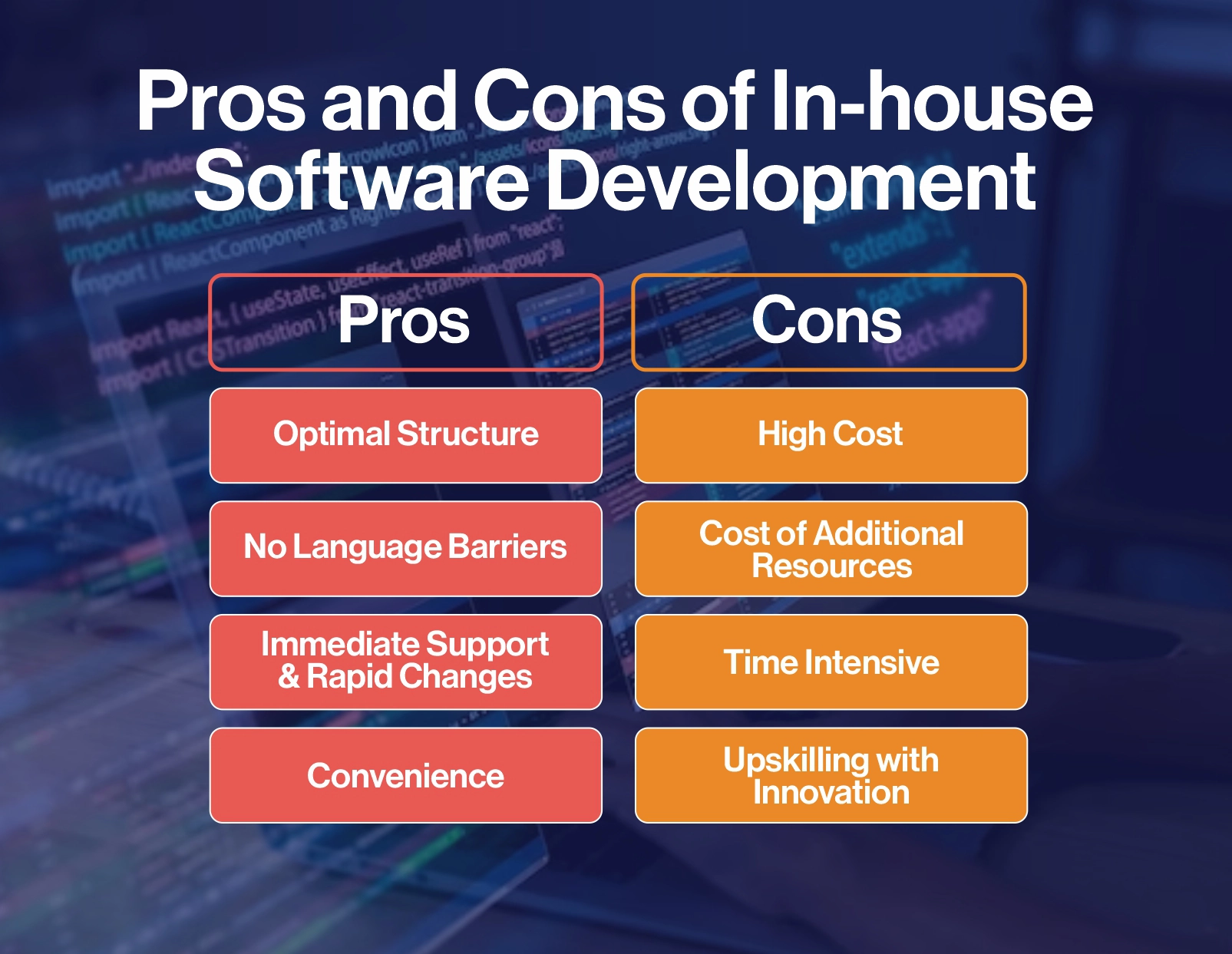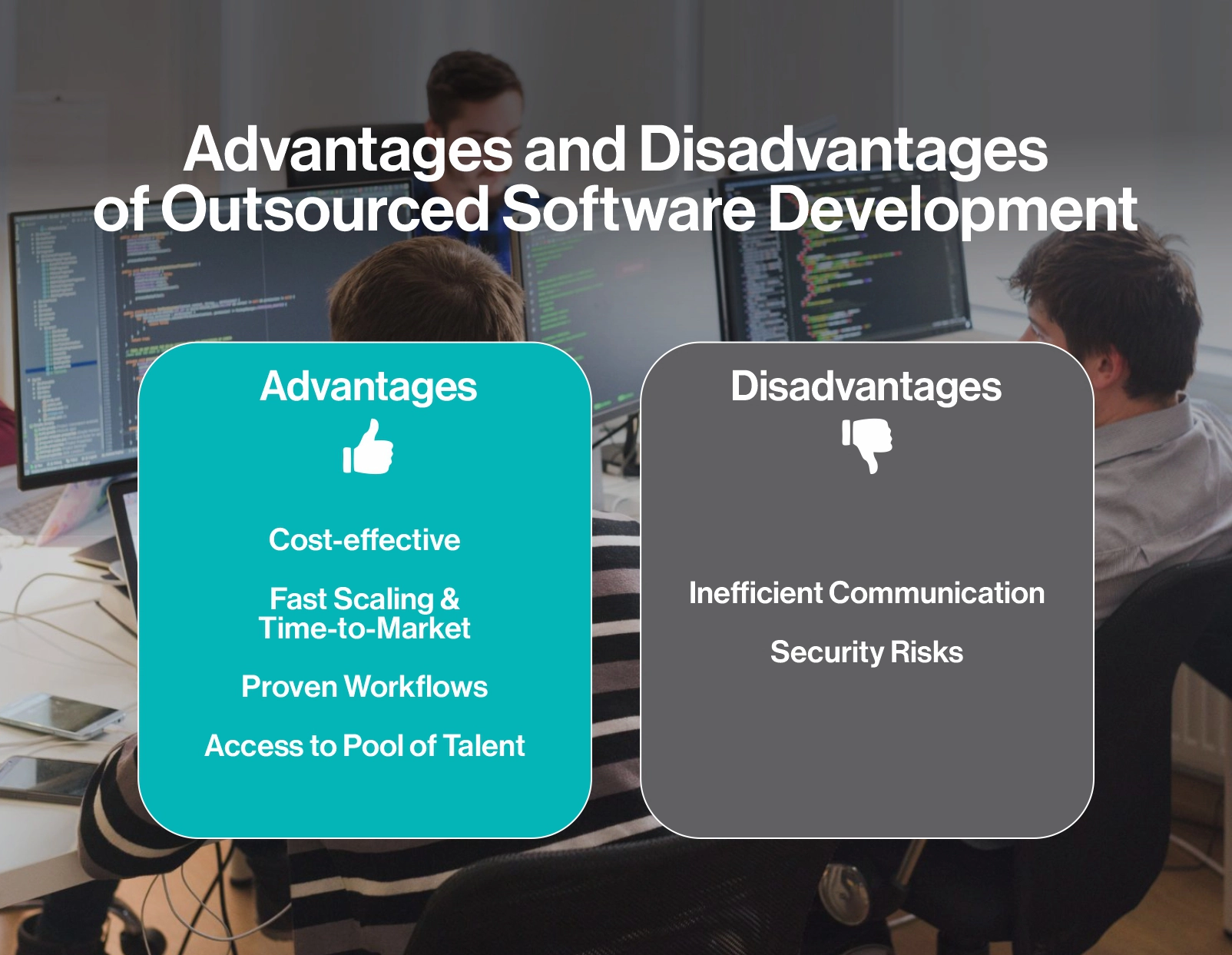With a dream in your head, the first question is always: How do I turn this idea into reality?
Where do I find professional resources, and how do I get development services on a budget?
Here’s another not-so-easy question that every tech startup has: Should we choose in-house software development or outsource the entire project?
Increasingly, businesses are entrusting external teams to manage their software development projects. Outsourcing has emerged as a viable alternative to in-house software development. Companies hire dedicated development teams to streamline and efficiently execute their software development tasks.
In this article, we’ll explore in-house vs outsourcing software development for you to make a wise decision.
In-House Software Development
In-house software development is when the software is developed by the company itself. It is also known as ‘insourcing’.
In-house development ensures that all the essential expertise and equipment are available within the organization. If you don’t have a team, you must build one from scratch, making sure the right skillset is hired. Considering an in-house development example, an organization needs to go through a detailed recruitment process, including interviews, onboarding, and training to build dedicated IT teams. The company always has access to experienced teams composed of software engineers, project managers, designers, and QA testers.
Indeed, this approach isn't without its drawbacks and challenges. One significant disadvantage is its potential for higher costs compared to outsourcing. Companies adopting this model must invest in essential personnel, equipment, and infrastructure to sustain development. Also, it tends to be more time-consuming, requiring the company to independently build and oversee the development team, adding to the overall project timeline.

Pros of In-House Development
Optimal Structure
In-house development is flexible as it allows you to create your own team by selecting members and the expertise of your choice. However, this requires more effort and time in the recruitment process, but this is worthwhile in certain situations. A fully tailored and dedicated team contributes to the enhanced value of the software project.
No Language Barriers
Most often, an in-house team of professionals has people that belong to the same area, city, or country. When team members use the same language and have a common cultural background, communication and collaboration become easier.
Immediate Support & Rapid Changes
With an in-house team always available, it is easier to make changes to the project quickly. With development models such as Agile and Waterfall model of software engineering, you can streamline your development efforts precisely. You can take updates from project managers anytime as there is no barrier of time zone or anything else. You do not need to pay external teams for additional features and can evolve the project anytime.
Convenience
Convenience is the major factor due to which software companies prefer hiring their own IT teams. The reason is that technical discussion, customizations, and regular updates on project progress are easily facilitated. The continuous involvement of the team in development processes helps resolve technical bugs quickly.
Cons of In-House Development
High Cost
One of the biggest disadvantages of an in-house development team is the high cost. The cost of hiring, training, maintenance and development is much more expensive as compared to obtaining development services from an external team. For instance, if you are building an in-house development team, you will bear the cost of salaries of employees, equipment (hardware and software), taxes, rents, employee benefits, training programs, utility expenses, etc.
Cost of Additional Resources
Members of an IT team are hired based on their skills and expertise, depending upon the nature and requirements of the project. In case of expandability or changes in the project, an employer would have to bear the cost of additional employees and all other benefits such as medical and life insurance, holidays, new equipment, etc.
Time Intensive
Finding an appropriate fit for the IT team is a tiresome task. Moreover, new employees need to define goals, get training, and attend meetings. One of the risks of in-house development is the dismissal of employees. The company has invested significant resources and training courses in the adaptation of employees, and when they go away, the company again has to invest in new members.
Upskilling with Innovation
One of the common issues for professionals is that they do not keep themselves updated with the latest innovations and technologies in the industry. The reason is that in an in-house team, there is little to no competition among developers, so they don’t pay attention to educating themselves more or enrolling in new IT programs. To keep employees motivated, an employer is responsible for paying for the upskilling and education of employees and for upgrading their equipment to make them compatible with advanced technologies.
Outsourced Software Development
In outsourced software development, some tasks or the entire project are outsourced to tech development companies. Outsourcing software development has gained significant traction among businesses aiming to tap into a broader talent pool, drive cost efficiencies, and expedite project timelines.
The primary advantage lies in accessing an expansive talent pool encompassing skilled developers specializing in various technologies, often locally unavailable. This access to specialized skill sets bolsters project capabilities. Moreover, outsourcing can yield cost savings by optimizing labor expenses and offering cost-effective development avenues.
However, potential risks accompany this approach. Communication challenges between clients and vendors might lead to delays or misunderstandings regarding project specifications. Also, relinquishing some control over the project is a common concern for companies engaging external providers.
IT outsourcing service stands as one of the largest industries worldwide, poised to reach a staggering $519 billion in global spending by 2023. ISG Research indicates that a substantial 92% of Forbes Global 2000 companies engage in IT outsourcing, while 59% actively pursue business process outsourcing. This strategic approach enables companies to concentrate on their core competencies while relegating repetitive tasks to external experts.

Advantages of Outsourcing
Cost-effective
The hand-picked members of the best software outsourcing companies have vast expertise in the field. When new requirements or issues arise, you do not need to hire new members because the expertise is already available. This not only helps reach goals faster but also reduces the expense of hiring new members.
Moreover, the cost of hiring in-house developers, testers, and designers is high in the US, Netherlands, UK, Canada, etc. as compared to outsourcing the projects to Pakistan, India, and Ukraine. Enterprises, therefore, prefer outsourcing their projects to offshore companies. Hence, IT outsourcing costs are low compared to in-house development costs.
Fast Scaling & Time-to-Market
IT outsourcing companies have professional resources available that work around the clock to decrease the time-to-market. Offshore companies have access to expertise readily without going through a detailed recruitment process.
Proven Workflows
Software project outsourcing companies have proven workflows. The entire team works together on a project and has already experienced working with each team member. The whole team acknowledges the work dynamics based on which an efficient workflow is followed by each team member.
The work pipeline works consistently throughout the project. This is one major advantage of outsourced software development in which your project is given to an already established team. From software engineers to scrum masters and testers to UI/UX designers, the whole team works together to deliver an absolute quality product without any hassle.
Access to Pool of Talent
Outsourcing services providers actively search for IT specialists with deep domain knowledge and proven experience in software development and SaaS. When a company is onboarded, a tailored team of experts becomes available for the project.
Want to learn more about the advantages of outsourcing SaaS product development? Then read our guide:
Saas Product Development Benefits
Disadvantages of Outsourced Software Development
Inefficient Communication
Considering in-house vs outsourcing pros and cons, one of the limitations of outsourcing is ensuring effective communication with clients. Due to language barriers, time zones, and cultural differences, communication suffers a lot.
Security Risks
Security risks in outsourcing are higher as compared to in-house development. It is because the team members are not part of your company. To ensure transparency, sign an NDA contract with the service providers to protect the idea and rights of the project.
In-house VS Outsourcing Software Development: Project-Level Decision Factors
A project-specific assessment becomes imperative when deliberating between in-house and outsourced software development. Several important factors come into play, spanning technical, operational, and financial considerations, each carrying its own weight in the decision-making process.
Costs and Resourcing
There's a common belief that outsourcing is inherently cheaper, but the reality is far more complex. Many advocating for outsourcing often aim to promote such services.
The real question isn't solely about cost but centers more on cost-effectiveness or, put differently, the return on investment (ROI).
The challenge arises from comparing different scenarios. One major factor is what's known as sunk costs, particularly prevalent in internal projects, though not exclusively.
For example, if we have an in-house developer team, their salaries are an ongoing cost that we can't evade. It's a sunk cost, inevitable regardless of our choices.
Therefore, our goal is to optimize the value gained from this investment. Outsourcing often focuses on finding the most affordable solution, assuming everything remains constant. While it might appear cheaper, the true cost-effectiveness depends on various other outcomes.
Improve Communications and Project Management
Internal projects typically excel in communications and project management, ensuring higher efficiency. This minimizes risks associated with misunderstandings and human errors while enhancing the team's responsiveness to user needs.
Consider internal tool development: the team has direct access to end users, facilitating prompt feedback and resolving queries efficiently.
In contrast, outsourced projects often involve communication through project managers, creating a chain before reaching internal stakeholders. This structure heightens the probability of errors or misinterpretations.
This streamlined communication within internal projects not only reduces risks but also enhances solution quality. End users' direct involvement significantly influences the project's outcome and functionality.
Control and Accountability
Assessing control and accountability becomes pivotal when weighing in-house app development vs outsourcing. These concepts, though connected, hold distinctive importance that merits separate consideration.
Control signifies the extent of influence wielded over decisions during the development phase, spanning technical aspects, project-related matters, financial aspects, timelines, resourcing, and strategy.
Accountability, on the other hand, revolves around handling incidents when things deviate from the plan.
The objective isn't to allocate blame but to establish clear accountability channels facilitating information gathering, strategizing, and prompt corrective action.
In-house development teams offer a robust advantage in both aspects. Familiarity with the team and active participation in structuring it empower setting control and accountability benchmarks. Also, it enables stakeholders to ensure more quality assurance and quality control. On the other hand, when you hire outsourcing team members, you may have to give up significant control and accountability.
Security, Confidentiality, and Data Exposure
Security considerations often sway the in-house vs outsourcing software development debate, sometimes making outsourcing implausible due to heightened confidentiality needs or complex contractor vetting.
Consider projects where confidentiality is paramount; disclosing sensitive or classified information to external vendors becomes impractical.
However, most situations demand limiting data exposure and maintaining control over security measures. While outsourcing remains an option, it necessitates additional strategies such as stringent vetting, dummy data use, and specific certifications.
Expediency, on the other hand, poses a nuanced comparison challenge between in-house and outsourcing solutions. Urgent projects might strain internal resources or require shifting priorities, impacting overall efficiency.
Turning to outsourcing might seem expedient, yet it introduces its own set of preliminary procedures like vetting, tendering, and negotiations, thus somewhat compromising the speed of delivery.
Opting for established and trusted vendors could mitigate delays. Nevertheless, determining whether in-house or outsourcing software development yields quicker results hinges on project-specific variables.
Lifecycle Management
Deciding between outsourcing or developing solutions in-house involves considering responsibility for activities beyond initial development, such as support, maintenance, deployment, and user onboarding.
Determining who manages these tasks is not a one-size-fits-all scenario.
Both in-house and outsourced approaches can handle these activities, although implementation might not be straightforward. For instance, if a solution is outsourced, internalizing lifecycle management relies on internal resources and vendor cooperation.
Conversely, outsourcing support for an internal project poses its own challenges. This involves vendor search and integration while balancing cost considerations. Ultimately, the decision to handle lifecycle management internally or through outsourcing hinges on resource availability and vendor willingness to collaborate.
In-House Vs Outsourcing Software Development: Which Is Better?
So, here is the difference between "In House vs Outsourcing Software Development".
Considering outsourcing vs in-house production, outsourcing software projects is a smart choice. According to Statista, IT outsourcing is expected to reach a combined revenue of $351 billion in 2021.
The reason is access to a talented pool of experts at a comparatively low cost. Outsourcing meets quality standards and ensures timely delivery of the product. It allows business owners to focus on the core values of an organization and let the external development team handle all operations.
However, choosing between in-house and outsource development could be easier after evaluating the project’s functional and non-functional requirements and need for resources. What may work for one project/company might not work for the other. In some cases, you might need to combine both to achieve the expected outcomes.
Simply, the right decision is the decision that fits the needs of your project and company.

